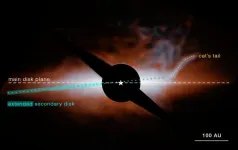(Press-News.org) A new wave of communication technology is quickly approaching and researchers at UBC Okanagan are investigating ways to configure next-generation mobile networks.
Dr. Anas Chaaban works in the UBCO Communication Theory Lab where researchers are busy analyzing a theoretical wireless communication architecture that will be optimized to handle increasing data loads while sending and receiving data faster.
Next-generation mobile networks are expected to outperform 5G on many fronts such as reliability, coverage and intelligence, explains Dr. Chaaban, an Assistant Professor in UBCO’s School of Engineering.
And the benefits go far beyond speed. The next generation of technology is expected to be a fully integrated system that allows for instantaneous communications between devices, consumers and the surrounding environment, he says.
These new networks will call for intelligent architectures that support massive connectivity, ultra-low latency, ultra-high reliability, high-quality experience, energy efficiency and lower deployment costs.
“One way to meet these stringent requirements is to rethink traditional communication techniques by exploiting recent advances in artificial intelligence,” he says. “Traditionally, functions such as waveform design, channel estimation, interference mitigation and error detection and correction are developed based on theoretical models and assumptions. This traditional approach is not capable of adapting to new challenges introduced by emerging technologies.”
Using a technology called transformer masked autoencoders, the researchers are developing techniques that enhance efficiency, adaptability and robustness. Dr. Chaaban says while there are many challenges in this research, it is expected it will play an important role in next-generation communication networks.
“We are working on ways to take content like images or video files and break them down into smaller packets in order to transport them to a recipient,” he says “The interesting thing is that we can throw away a number of packets and rely on AI to recover them at the recipient, which then links them back together to recreate the image or video.”
The experience, even today, is something users take for granted but next-generation technology—where virtual reality will be a part of everyday communications including cell phone calls—is positioned to improve wireless systems substantially, he adds. The potential is unparalleled.
“AI provides us with the power to develop complex architectures that propel communications technologies forward to cope with the proliferation of advanced technologies such as virtual reality,” says Chaaban. “By collectively tackling these intricacies, the next generation of wireless technology can usher in a new era of adaptive, efficient and secure communication networks.”
The research is published in the latest issue of IEEE Communications Magazine.
END
Artificial intelligence helps unlock advances in wireless communications
UBC Okanagan researchers are clearing the way for the next generation of wireless technology
2024-01-11
ELSE PRESS RELEASES FROM THIS DATE:
Personalizing lifestyle interventions for cancer survivors
2024-01-11
MIAMI, FLORIDA (Jan. 10, 2024) – Researchers with Sylvester Comprehensive Cancer Center at the University of Miami Miller School of Medicine have received funding to better understand how personalized nutrition and exercise programs can improve quality of life after cancer treatment.
The three-year, approximately $700,000 grant from the Applebaum Foundation with added support by Sylvester, will fund the On Precision Oncology Interventions in Nutrition and Training (OnPOINT) clinical study to develop individualized diet and activity programs ...
Louisiana Cancer Research Center accepting applications for summer undergraduate research program - SUCRE
2024-01-10
January 10, 2024, New Orleans, LA - College students interested in pursuing a career in cancer research are urged to apply to The Louisiana Cancer Research Center’s 8-week Summer Undergraduate Cancer Research Experience, SUCRE.
Selected students can explore and develop their interests by working in a research lab with an assigned faculty mentor from member institutions Louisiana State University Health Sciences Center - New Orleans, Tulane School of Medicine and Xavier University of Louisiana.
The program runs from Thursday, June 3 through Friday, July 26, 2024. ...
NASA’s Webb discovers dusty ‘cat’s tail’ in Beta Pictoris System
2024-01-10
Beta Pictoris, a young planetary system located just 63 light-years away, continues to intrigue scientists even after decades of in-depth study. It possesses the first dust disk imaged around another star — a disk of debris produced by collisions between asteroids, comets, and planetesimals. Observations from NASA’s Hubble Space Telescope revealed a second debris disk in this system, inclined with respect to the outer disk, which was seen first. Now, a team of astronomers using NASA’s James Webb Space Telescope to image the Beta Pictoris system (Beta Pic) has discovered a new, previously unseen structure.
The ...
Texas A&M AgriLife Research gets $5.2 million grant for onion improvement
2024-01-10
Texas A&M AgriLife Research received more than $5.2 million in grant funding from the U.S. Department of Agriculture’s National Institute of Food and Agriculture for a project to address multiple aspects of the southern U.S. onion harvest system.
Subas Malla, Ph.D., Texas A&M AgriLife Research associate professor at the Texas A&M AgriLife Research and Extension Center in Uvalde, will serve as director for a short-day onion project. (Texas A&M AgriLife photo by Paul Schattenberg)
The director for the “Ensuring Future Economic Viability of U.S. Short-Day ...
Preeclampsia and preterm birth risk may be reduced by calcium dose lower than current WHO standard
2024-01-10
Key points:
According to two trials of 11,000 pregnant women in India and in Tanzania, low-dose calcium supplementation (500 milligrams per day) appears as effective at reducing the risk of preeclampsia and preterm birth as high-dose calcium supplementation (1,500 milligrams per day).
The World Health Organization currently recommends high-dose calcium supplementation—equivalent to three calcium pills a day—for pregnant women in contexts with low-calcium diets, predominantly low- and middle-income countries. Lowering the pill burden to one 500mg ...
MSU-led study: Majority of US hospitals found COVID-19 reporting directives to be inconsistent
2024-01-10
EAST LANSING, Mich. – The U.S. health care response during the early stages of the COVID-19 pandemic unveiled challenges in public health reporting systems and electronic clinical data exchange.
A new study led by John (Xuefeng) Jiang, Eli Broad Endowed Professor of Accounting in MSU’s Broad College of Business, examines U.S. hospitals’ experiences in public health reporting, accessing clinical data from external providers for COVID-19 patient care, and their success in reporting vaccine-related ...
Janelia shares ‘greatest hits’ of tools to study the fly brain
2024-01-10
The holidays may be over, but neuroscientists are getting a special gift to kick off the new year: access to a greatest hits collection from one of Janelia’s longest running and successful Project Teams.
Janelia’s FlyLight Project Team, which has worked for more than a decade to create tools to study the fly brain, is making a core collection of their best genetically engineered fly strains available to researchers worldwide through the Bloomington Drosophila Stock Center. The brain images of these flies, along with hundreds of thousands of images from thousands of additional fly lines, are also now freely accessible through Janelia websites.
These ...
Integrating dimensions to get more out of Moore’s Law and advance electronics
2024-01-10
UNIVERSITY PARK, Pa. — Moore's Law, a fundamental scaling principle for electronic devices, forecasts that the number of transistors on a chip will double every two years, ensuring more computing power — but a limit exists.
Today's most advanced chips house nearly 50 billion transistors within a space no larger than your thumbnail. The task of cramming even more transistors into that confined area has become more and more difficult, according to Penn State researchers.
In a study ...
Need for speed: How hummingbirds switch mental gears in flight
2024-01-10
Hummingbirds use two distinct sensory strategies to control their flight, depending on whether they’re hovering or in forward motion, according to new research by University of British Columbia (UBC) zoologists.
“When in forward fight, hummingbirds rely on what we call an ‘internal forward model’—almost an ingrained, intuitive autopilot—to gauge speed,” says Dr. Vikram B. Baliga, lead author of a new study on hummingbird locomotion published in Proceedings of the Royal Society B. ...
Wristband monitors provide detailed account of air pollution exposure
2024-01-10
Environmental epidemiologists at Columbia University Mailman School of Public Health, in collaboration with an interdisciplinary team of researchers at Oregon State University, Pacific Northwest National Labs, and Mt. Sinai School of Medicine, report on the findings of a new study of air pollution exposures collected using personal wristband monitors worn by pregnant individuals in New York City matched with data from a questionnaire. Factors predictive of exposures to air pollution include income, time spent outdoors, maternal age, country of birth, transportation type, and season.
The researchers examined an unprecedented number ...
LAST 30 PRESS RELEASES:
Deep neural networks enable accurate pricing of American options under stochastic volatility
Collective risk resonance in Chinese stock sectors uncovered through higher-order network analysis
Does CPU impact systemic risk contributions of Chinese sectors? Evidence from mixed frequency methods with asymmetric tail long memory
General intelligence framework to predict virus adaptation based on a genome language model
Antibiotic resistance is ancient, ecological, and deeply connected to human activity, new review shows
Vapes, pouches, heated tobacco, shisha, cigarettes: nicotine in all forms is toxic to the heart and blood vessels
From powder to planet: University of Modena engineers forge a low-carbon future for advanced metal manufacturing
Super strain-resistant superconductors
Pre-school health programme does not improve children’s diet or physical activity, prompting call for policy changes, study finds
Autumn clock change linked to reduction in certain health conditions
AI images of doctors can exaggerate and reinforce existing stereotypes
Where medicine meets melody – how lullabies help babies and parents in intensive care
We may never be able to tell if AI becomes conscious, argues philosopher
AI video translation shows promise but humans still hold the edge
Deep ocean earthquakes drive Southern Ocean’s massive phytoplankton blooms, study finds
Without campus leftovers to pick through, the beaks of this bird changed shape during the pandemic
High-dose antibiotic does not reduce mortality in tuberculous meningitis
How many insects fly in the sky above the USA?
Could cheese protect your brain health?
Who faces more difficulty recovering from stroke?
Colliding galaxies create the brightest, fastest growing black holes at their center
New BrainHealth research reveals tradeoffs on sleep with cannabis use for chronic pain
Aging-US now on ResearchGate, enhancing visibility for authors and readers
'Molecular glue' stabilizes protein that inhibits development of non-small cell lung cancer
Mount Sinai Health System is recognized in 2025 Chime Digital Health Most Wired survey
From prey to predator: How carnivores spread beneficial fungi
Menopause symptoms may be frequent and have negative effects, according to female endurance athletes
US Congressmembers’ responses on X to mass shooting events differ along party lines
KAIST-UEL team develops “origami” airless wheel to explore lunar caves
Individual genetic differences render some therapies ineffective
[Press-News.org] Artificial intelligence helps unlock advances in wireless communicationsUBC Okanagan researchers are clearing the way for the next generation of wireless technology






